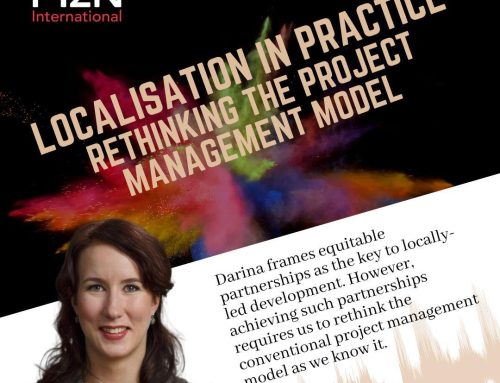Five things’ leaders should consider in order to lead in a new reality.
by Christian Meyer zu Natrup, October 2022
Many people believe we still live in a world that does not exist anymore. A world that is manageable with only a few major humanitarian disasters a year. A world that is predictable, with traditional economic cycles and stable seasons. A world that is civil, where we return to the rule of law internationally. Unfortunately, many nonprofit and business leaders are amongst them.
However, this new reality is different for several reasons. The disastrous effects of the climate crisis are so clear, it now takes incredible will-power to ignore them. Wild fires, more potential pandemics, water and energy shortages, breaking supply chains, and a record humanitarian aid shortfall make it difficult to see 2021-2022 as just another couple of bad years. What makes this more than a pile of unfortunate events, however, is the interdependence and interconnectivity of these crises. Add to that their sheer speed and scale, and most will admit that this is different.
Despite this, the mindset does not shift with every leader. The CEO of a charity in Brussels recently launched a new strategy with the words “Recovering from the crisis and building back”. A social venture capitalist from New York I work with asked prospects to put together a “Get back to normal- plan” before investing. And a humanitarian worker in Greece’ proposal started with the words “Once the current migration crisis is over…”.
I understand the notion. It is tempting to think that there is light at the end of the tunnel.
We all want to get back to a time without crisis and disruption. The problem is: We likely won’t.
And we need to embrace that. Come to terms with the fact, that there is much less peace, stability and predictability in the world and that this will likely be the case for the rest of our and our children’s lifetimes. So what now?
Good leaders who recognize this do five things to manage and lead their organisations, and themselves.
1) Nurture people
Many are not well. The pandemic continues to take a toll on our health and relationships. Many of us are now carers and must balance all the worry, long hours and stress that comes with that. The cost-of-living crisis makes the weekly shop a horrifying chore, accompanied by the constant fear that we cannot heat our flats this winter. Here in Europe, war is back on our shores and all the while work stress seems to have increased exponentially as staffing shortages leave more work to fewer people, often working with systems and processes that are just no longer suitable.
One client I worked with summed it up, “I came back into the office to see that everything’s changed – except the way we work.”
Acknowledging these changes are a necessary first step to address this. However, lofty promises or patchwork solutions hoping for an end to this crisis won’t help. Leaders need to nurture people by making work work for people again.
Good leaders should actively redesign and simplify workflow processes that perform in a hybrid (part office, part digital) organisation.
A good example was the owner of a automotive supplier who set no-meeting days weekly, giving staff a change to breathe, think and catch up. They also examined each and every workflow, from expense approval to campaign management, and redesigned it to minimize the need for synchronous meetings, often introducing a new project management platform where staff can log on, read what is going on and work on their tasks, when and where it suits them. They even considered banning internal meetings all together.
Being clear on expectations also helps. The Managing Director of a charity in DC asked his Department Directors to name no more than three expectations for each staff member. Just three. Everything else becomes secondary and a nice-to-have. Staff reacted with relief: the work was not easier, but finally the priorities were clear. The process itself has helped people to connect too.
In short:
- Kill more meetings: design work- and decision-making processes that can work without synchronous meetings, giving people more time to work when and where they need to, in peace.
- Make expectations clear: set no more than three priorities for each member of staff. This assures people of their scope, reduces uncertainty and creates stability. It also means that more can be achieved.
2) Diversify your income – fast
Charities and business who rely on too few income sources are far more likely to experience financial distress than those who have a more balanced income portfolio. My colleagues at MzN International provide income intelligence and support to many charities: “It is not so much about the absolute size of the funding. What really matters is diversity” says Joseph Nelson, Senior Consultant at MzN International.
Of course, charities have spoken about funding diversity since the 90’s. But those who have actually added new donors, a multi-channel fundraising function or an effective corporate partnership scheme to their Business Development are, unsurprisingly, more stable, less vulnerable to the political winds and more authentic in their strategy to produce real impact and achieve change.
Our analysis shows that NGOs with a more diversified funding base have grown, even through the pandemic lock-downs last year. Diversifying does not mean reducing our core donors either. Our most successful NGO partners have increased their core donor income, whilst adding two or three new or increased sources of funding. The effect of this modest change is profound. Balancing out restricted funding where needed, the charity can be more certain to have the resources to produce impact.
In short
- Grow your key donors
- Add at least two new income sources, however small they are at first.
3) Go agile – for real this time
Digital project management and other systems are more resilient, cheaper to run and can be more easily updated than work processes that rely heavily on people being together, either in location or time (or even both).
Of course, building an agile organisation is not (just) about going digital. In fact, the problem is not such the availability of the right tool, the challenge in going agile is the work process design that is not sufficiently development to match the new realities.
To be truly competitive and efficient, we need processes and tools that allow our teams to pull in one direction, regardless from where and when they work. Core processes need to be rewritten and updated for agile. That does not mean that we need to redesign every process. Concentrate on decision making and those work processes that really matter to get our work done. Deciding which ones these are, is an iterative process, but it is not complicated. We just need to listen to our staff.
In many organisations, going agile often means setting up completely new functions. A large NGO we currently work with has gone so far as to completely abolish its partnership unit and build a new business development unit from the ground up.
It also ensures that it asks difficult questions such as “how do we relate to each other and work with each other?”. Another mid-sized charity we work with is currently redefining its HQ role and the management behavior within it, whilst yet another is refining their project management processes to delegate authority to the Global South and standardize key performance indicators across their global organisation.
In essence, going agile has an advantage in the new reality because agile organisations are not based around strictly hierarchical decision-making trees, siloed departments and business models that were built when everyone was in the office dealing with one single crisis. Today, traditional organisations simply choke up, suffering bottlenecks and widespread frustration when more than one crisis hones into view.
To be capable of working efficiently today, we need organisations that pivot faster, learn more and are capable of morphing quickly into new shapes. And they need to do so without losing their identity, stressing out their teams and being too pre-occupied with themselves. They also need to be able to work anywhere – fast.
In short:
- Go agile – for real this time.
- Identify what your team really needs to get work going… and keep the list short.
4) Learn every day
You are what you read and what you eat. What is true for humans, is also true for organisations. But this old wisdom is hard to apply in the age of information overload. The last thing we need is more information. Instead, we need better and more relevant lessons to learn.
Deciding what to read, understand and think about can be hard when information is flooding over us from every angle. However, a good rule of thumb can be to look at recent failures and successes. Every month, we all have small and sometimes larger failures and successes. If no insight was generated from them, if no-one discussed then, then chances are that a major learning opportunity will have been missed.
One rights-advocating NGO from Sweden took this to heart by requiring and giving managers 2 days off per quarter in which they could be disconnected from their emails and asked to think what they learned in the last three months. Every three months. Logging this was flexible, they could write it up or speak into a video stream. And their ideas could focus on any element of the organisation (subjects ranged from Yoga to donor strategies).
Another good guide is using money. Nearly everything we do (and even the stuff that we don’t) has a financial impact. Either an income is missed, generated or an expense has occurred (or not where you would expect one). If you cannot find any financial hint after a recent event, then either nothing was done to learn from the experience (i.e. there should have been an investment to fix problem X or build solution Y), or your finance team is not skilled enough to report on such matters (which could then serve as the first learning point).
In short
- Something, somewhere always goes wrong. That is OK, but how did we learn from it?
- Use money and management accounting as a detective tool to identify missed learning opportunities.
5) Take care of yourself – then love others more
Do you care enough for yourself? Do you give others enough love? To a large degree , life is now more unpredictable, more stressful and more exhausting than it was previously.
Getting used to this new reality takes a lot of energy. That energy does not come from nowhere.
The ability not to get consumed by the crisis of the day takes a lot of mental discipline and effective de-stressing capabilities. And like much of what happens today, these skills re-energizing and de-stressing also need upgrading.
Those upgrades come in many forms. For some of my colleagues it has come from producing art. Others garden, write or cook. For me, it has become about fitness. For a few hours every week, I am not a father, project leader, humanitarian or entrepreneur, but just someone who runs, lifts and works out. This change made me relax, fast. And as things became more intense, so did my gym sessions.
When I work on me, I have more energy to love others and give back to my community. I come back from the gym with more love for those around me, more capacity to support, and more empathy.
In short:
- More stress requires more de-stressing. Boost your coping mechanism, in whichever way works best for you.
- As the crises start piling up, so should your ability to love yourself and others.
It’s natural to wish for the light at the end of the tunnel. But science is clear that we cannot avoid the climate disaster anymore. We need to find ways of working better in this new reality. We can still work on building a better world by accepting the new reality and creating better organisations, that are more agile, robust and effective. The better we do this, the more likely is it that the light at the end of the tunnel, is not the approaching train.





